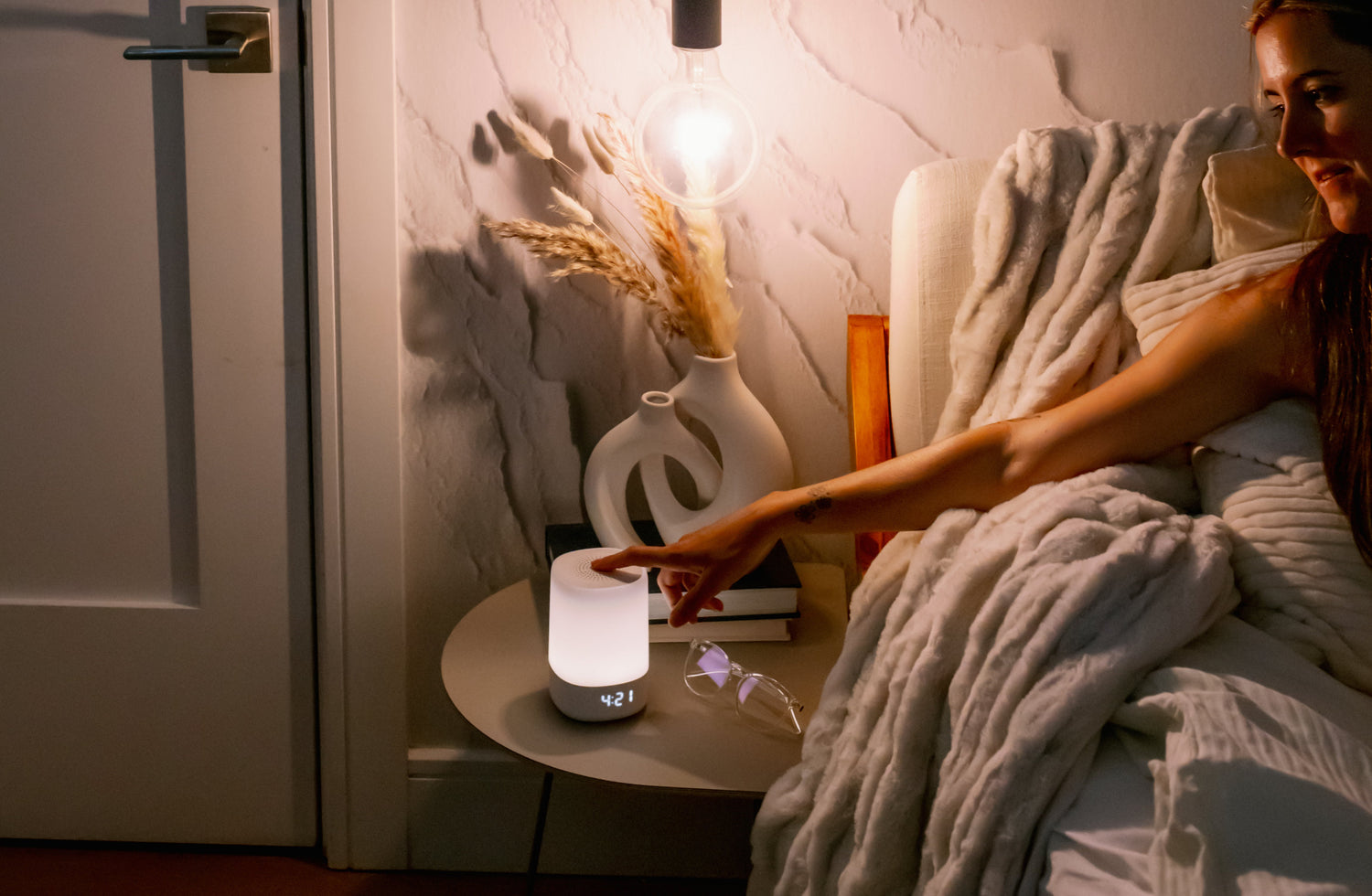Many moms-to-be eagerly await some of pregnancy’s most anticipated moments, like seeing their baby on that first ultrasound, learning their baby’s gender, and feeling those first few kicks. One less pleasant aspect of pregnancy is the never-ending quest to find the best sleep positions for a night of comfortable rest for nine months.
If we’re being honest, growing a tiny human makes sleep much harder to come by. With approximately 80% of pregnant women experiencing poor sleep, navigating this challenge is the norm for many.
With a practical grasp of safe pregnancy sleeping positions and some effective tips on managing sleep during pregnancy, you'll be better equipped for the challenges faced by expecting parents and for the reality of sleep disruptions once your baby is born.
Why is sleep so important during pregnancy?
Before entering parenthood, the luxury of sleep often goes unappreciated. You can rest whenever you please because a baby isn't dictating your entire sleep schedule. But once you’re pregnant, the fleeting nature of sleep quickly becomes apparent—and the baby hasn't even arrived yet. Pregnancy night sweats, discomfort from a growing belly, and other common pregnancy concerns underscore the importance of ensuring you get the recommended seven to nine hours of sleep each night during this transformative time.
Why is it crucial to ensure you get the recommended 7-9 hours of sleep each night?
There are several reasons to prioritize rest, one of them being the tremendous amount of effort your pregnant body expends throughout the day. For instance, during pregnancy, your blood volume increases to transport oxygen and nutrients to your baby. This prompts your heart to pump faster to accommodate the extra volume.
Although you may not wear a cape, your body is wielding superpowers to form tissues, organs, and everything necessary for your little one's full development in just nine months.
Quality sleep is not only crucial for physical well-being but also for mental health. Adequate rest is associated with better mood regulation, reduced stress levels, and enhanced cognitive function. By prioritizing your sleep, you're not just supporting your body's superhero efforts, you’re also nurturing your mental well-being during this transformative time.
Sleep positions to strive for (and avoid)
Sure, sleep is important during pregnancy. But as your belly grows, it can become more challenging to find pleasure in sleeping in your favorite pre-pregnancy position — or any position at all, for that matter. This begs the question, how do you get comfortable enough to sleep soundly? More importantly, what are some safe sleeping positions while pregnant?
Here, we discuss which positions are safest during pregnancy, and which you should avoid:
On your back
Back sleeping is generally safe in early pregnancy, but experts suggest opting for a new position from the midpoint of the second trimester onward. They exercise this caution because the extra weight of your uterus can compress the blood flow to your baby. However, recent studies suggest this position may be safe until around the 30th week. If you feel uncertain or have concerns, consult your OBGYN for personalized guidance on safe pregnancy sleep positions for you and your baby.
On your side
Experts often advise pregnant people to sleep on their sides from the second trimester through the remainder of their pregnancy. Sleeping on the left side in particular provides optimal blood circulation, helping to distribute nutrients and oxygen to you and your baby. As a bonus, this particular side-lying position can also decrease the likelihood of leg and ankle swelling, but don’t let that deter you from sleeping on the right side if that’s what’s most comfortable for you.
On your stomach
Feel free to sleep on your stomach as long as your growing belly permits. When your baby and belly outgrow this position, consider switching to a different sleeping position or investing in a pregnancy pillow with a hole in the middle. These pillows are designed to accommodate your burgeoning belly, allowing you to enjoy your favorite sleep position more comfortably.
Tips for finding a comfortable sleep position
While you may favor one sleep position, that doesn’t mean that your preferred position provides you the support you need to help you sleep comfortably. Try these tips to get your best, uninterrupted rest:
- Utilize support pillows. As your pregnancy progresses, enlist a few selective pillows to become your besties in bed. You can strategically place them under your belly, between your knees, and behind your back for additional support. If you really want to treat yourself, you might choose to invest in a maternity pillow, a giant U- or C-shaped pillow that makes it easier to support your changing body from head to toe. Pro tip: A breathable cover can make these foam body pillows much less warming!
- Bend your knees. If you’re sleeping on your side or back, try sleeping with your knees bent to offer additional back support.
- Stay elevated. If you experience heartburn at night, consider adding a few pillows to the standard one behind your head. Elevating your upper body provides additional support, allowing you to sleep in a more upright position and potentially alleviating uncomfortable symptoms.
- Sleep on the left side of the bed. If you’re not naturally a left-side sleeper, switching to that side of the bed might make you more inclined to turn to your left side when you sleep.
How to achieve better sleep during pregnancy
In addition to modifying your usual sleep position to accommodate the growing pains of pregnancy, there are other strategies you can implement to help you achieve better sleep.
Reserve the bedroom for sleep
Pregnancy fatigue is difficult, and if you work from home, it can be tempting to bring your laptop to bed and complete a few tasks from the comfort of your cozy haven. However, this practice may associate your bed with daytime activities, potentially hindering your ability to unwind when it's time to sleep.
Instead, you can transform your bedroom into a sleep-inducing sanctuary by minimizing noise, dimming the lights at bedtime, and eliminating digital distractions like TV or social media scrolling.
Establish a sleep schedule
Set your circadian rhythm up for success by going to bed and waking up at the same time each day. Once it becomes second nature, you might notice that you’re naturally tired at the same time each night—and even manage to wake yourself up right before your alarm every morning.
Rest when you need it
If nighttime sleep eludes you, or if you experience pockets of exhaustion during the day, be kind to yourself and embrace a nap when the opportunity arises. If you're working to establish a consistent nighttime sleep routine, consider scheduling your naps earlier in the day to make sure you’ll be tired by bedtime, and limit your nap durations to around 30 minutes to avoid disrupting your nighttime sleep schedule.
Incorporate regular exercise
Engaging in exercise during pregnancy offers many benefits, with one standout advantage being its potential to enhance your nighttime sleep. Whether you enjoy taking a walk to absorb some vitamin D from the sun or participating in a prenatal yoga class, there are numerous exercise options to consider, including but not limited to:
- Swimming
- Riding a stationary bike
- Low-impact HIIT exercises
- Strength training
While the optimum time and intensity of your exercise will vary based on your fitness level before becoming pregnant, aim for two and a half hours of exercise each week or approximately 30 minutes a day.
Limit caffeine intake
If you enjoy that morning cup of caffeine, be it a steaming mug of coffee or an ice-cold fizzy soda, by all means, treat yourself. If an afternoon wave of exhaustion strikes, however, try not to reach for the nearest caffeinated beverage.
Not only can it make it more challenging for you to fall asleep later, but The American College of Obstetricians and Gynecologists also states that pregnant women should only consume approximately 200 mg (about two six-ounce cups) of caffeine each day. Instead of another cup of coffee, try stretching or going outside for a few minutes to give yourself a boost of energy.
Choose simple food and drinks before bedtime
If you suffer from heartburn at night, opt for smaller snacks that are easy to digest, such as crackers with cheese or low-fat yogurt and toast. They’ll satisfy your late-night hunger cravings while also diminishing some of the pesky symptoms of heartburn, like:
- Burning in your chest
- Pain that increases when lying down
- A bitter taste in your mouth
Find your best rest with Nanit
Remember that it’s normal for your sleep patterns to change when you’re pregnant, and that you’re not alone if you’re finding it hard to achieve quality rest. However, if you’re concerned that your lack of sleep is impacting your quality of life, consult your healthcare provider.
Once your bundle of joy arrives, worries about their safety might keep you up at night. You can ease these worries and enhance your sleep quality with Nanit.
With a Nanit Pro Camera, you’ll rest easy knowing that our award-winning smart baby monitor and sensor-free Breathing Wear are tracking your baby’s breathing, growth, and sleep patterns for your peace of mind. Join the 71% of Nanit parents who reported reduced anxiety with Nanit at their baby’s side.
Key takeaways
- Sleeping on your side, especially the left side, is recommended during pregnancy for optimal blood circulation and decreased risk of complications.
- Use support pillows to provide additional support for better sleep.
- Transform your bedroom into a cozy cocoon for sleep by establishing a sleep schedule, resting when needed, and incorporating regular exercise.
Sources
NIH. Pregnant Women’s Attitudes and Beliefs towards Sleep and Exercise: A Cross-Sectional Survey. https://www.ncbi.nlm.nih.gov/pmc/articles/PMC9944079
NIH. How Much Sleep Is Enough? https://www.nhlbi.nih.gov/health/sleep/how-much-sleep
NIH. Physiological Changes in Pregnancy. https://www.ncbi.nlm.nih.gov/pmc/articles/PMC4928162/
National Journal of Physiology, Pharmacy, and Pharmacology. A comparative study of arterial oxygen saturation in pregnant and nonpregnant women. https://www.njppp.com/fulltext/28-1495164058.pdf
John Hopkins Medicine. Get a Good Night’s Sleep During Pregnancy. https://www.hopkinsmedicine.org/health/conditions-and-diseases/staying-healthy-during-pregnancy/get-a-good-nights-sleep-during-pregnancy
NIH. Science Update: Sleeping position during early and mid pregnancy does not affect risk of complications, NIH-funded study suggests. https://www.nichd.nih.gov/newsroom/news/092019-pregnancy-sleep-position
American Pregnancy Association. Best Sleeping Positions During Pregnancy. https://americanpregnancy.org/healthy-pregnancy/pregnancy-health-wellness/sleeping-positions-while-pregnant/
March of Dimes. Exercise During Pregnancy. https://www.marchofdimes.org/find-support/topics/pregnancy/exercise-during-pregnancy
Penn Medicine. Moderate Amounts of Caffeine Not Linked to Maternal Health Risks. https://www.pennmedicine.org/news/news-releases/2021/november/moderate-amounts-of-caffeine-not-linked-to-maternal-health-risks








































